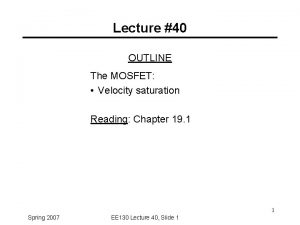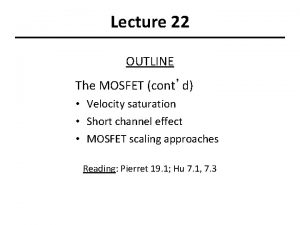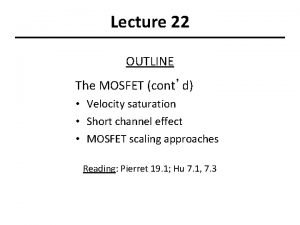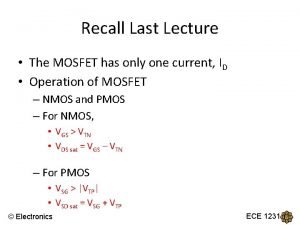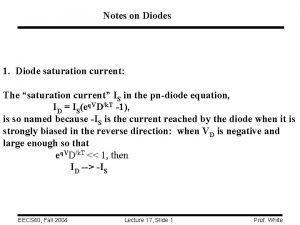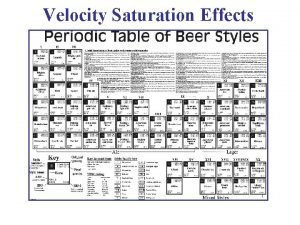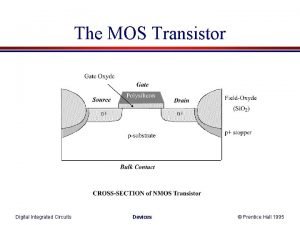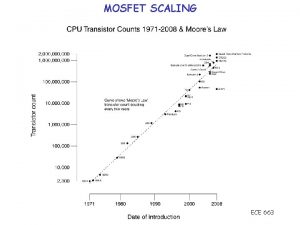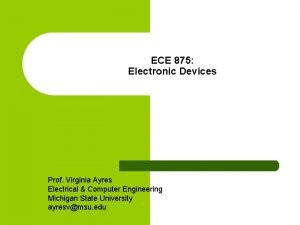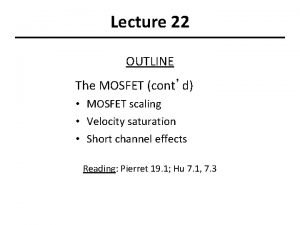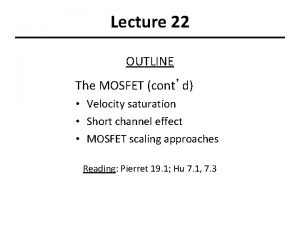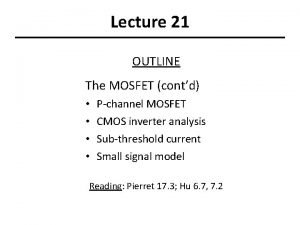Lecture 40 OUTLINE The MOSFET Velocity saturation Reading











- Slides: 11

Lecture #40 OUTLINE The MOSFET: • Velocity saturation Reading: Chapter 19. 1 1 Spring 2007 EE 130 Lecture 40, Slide 1

Velocity Saturation Velocity saturation limits IDSsat in modern MOSFETS Simple model: for e < e sat for e esat is the electric field at velocity saturation: 2 Spring 2007 EE 130 Lecture 40, Slide 2

MOSFET I-V with Velocity Saturation In the linear region: 3 Spring 2007 EE 130 Lecture 40, Slide 3

Drain Saturation Voltage VDSsat • If esat. L >> VGS-VT then the MOSFET is considered “long-channel”. This condition can be satisfied when – L is large, or – VGS is close to VT 4 Spring 2007 EE 130 Lecture 40, Slide 4

EXAMPLE: Drain Saturation Voltage Question: For VGS = 1. 8 V, find the VDSsat of an NFET with Toxe = 3 nm, VT = 0. 25 V, and WT = 45 nm, if L = (a) 10 mm, (b) 1 um, (c) 0. 1 mm, and (d) 0. 05 mm Solution: From VGS , VT, and Toxe , mn is 200 cm 2 V-1 s-1. esat= 2 vsat / mn = 8 104 V/cm m = 1 + 3 Toxe/WT = 1. 2 5 Spring 2007 EE 130 Lecture 40, Slide 5

(a) L = 10 mm: VDSsat= (1/1. 3 V + 1/80 V)-1 = 1. 3 V (b) L = 1 mm: VDSsat= (1/1. 3 V + 1/8 V)-1 = 1. 1 V (c) L = 0. 1 mm: VDSsat= (1/1. 3 V + 1/. 8 V)-1 = 0. 5 V (d) L = 0. 05 mm: VDSsat= (1/1. 3 V + 1/. 4 V)-1 = 0. 3 V 6 Spring 2007 EE 130 Lecture 40, Slide 6

IDSsat with Velocity Saturation Substituting VDSsat for VDS in the linear-region IDS eq’n. gives: For very short channel length: • IDSsat is proportional to VGS–VT rather than (VGS – VT)2 • IDSsat is not dependent on L 7 Spring 2007 EE 130 Lecture 40, Slide 7

Short- vs. Long-Channel MOSFET Short-channel MOSFET: • IDsat is proportional to VGS-VTn rather than (VGS-VTn)2 • VDsat is lower than for long-channel MOSFET • Channel-length modulation is apparent 8 Spring 2007 EE 130 Lecture 40, Slide 8

Velocity Overshoot • When L is comparable to or less than the mean free path, some of the electrons travel through the channel without experiencing a single scattering event projectile-like motion (“ballistic transport”) Þ The average velocity of carriers exceeds vsat e. g. 35% for L = 0. 12 mm NMOSFET Þ Effectively, vsat and esat increase when L is very small 9 Spring 2007 EE 130 Lecture 40, Slide 9

Summary: NMOSFET I-V • Linear region: • Saturation region: 10 Spring 2007 EE 130 Lecture 40, Slide 10

PMOSFET I-V with Velocity Saturation • Linear region: • Saturation region: 11 Spring 2007 EE 130 Lecture 40, Slide 11
